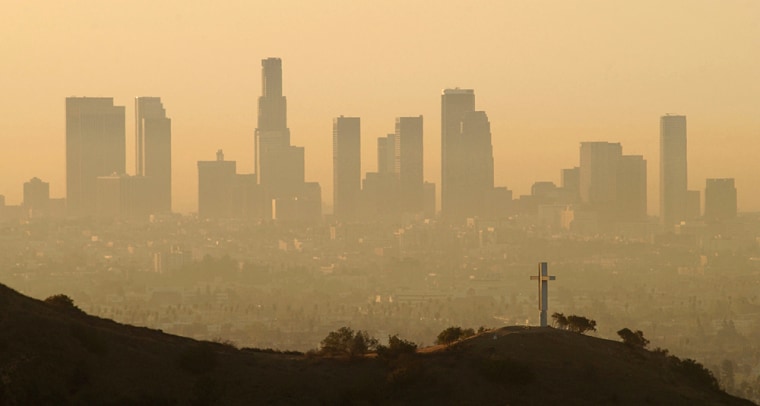More than half the nation’s population lives in counties — many in California — with hazardous smog levels, according to a report released Thursday by the American Lung Association.
The annual report concluded that about 159 million Americans, or 55 percent of the country, reside in 441 counties threatened by air that’s heavily polluted with ozone or tiny particles of soot, known as particle matter.
California has a majority of the top 10 worst-polluted counties.
In terms of metropolitan areas, Southern California ranked worst on ozone pollution for the fifth straight year. It was followed by Fresno, Bakersfield and Visalia — all California areas. The Houston area was fifth.
California stats
According to the report, California counties took four of the top five spots among worst counties nationwide in terms of ozone pollution. San Bernardino ranked number one.
In terms of particulate matter pollution, California's Riverside County had the nation’s worst levels. Like San Bernardino, Riverside is in Southern California.
Overall, 34 of California’s 58 counties failed one or more of three clean air tests in the study.
Ozone pollution occurs when hydrocarbons and nitrogen oxides — released when fossil fuels burn or chemicals evaporate — combine with heat and sunlight.
Particle pollutants can come from fireplaces, autos and agriculture. They can lodge deep in the lungs, contributing to heart problems and sometimes leading to death over longer periods of exposure.
Southern California's clean air agency had tried to stop large commercial fleet operators from buying diesel trucks, which are a key source of particulate matter, or soot, but the U.S. Supreme Court on Wednesday ruled that local jurisdictions may not trump federal clean air rules.
EPA counters with optimism
Even before the report was out, the Environmental Protection Agency on Wednesday issued a statement emphasizing that "ozone levels nationwide are the lowest they have been since 1980."
Conservative scholars and industry echoed that view.
“You wouldn’t realize we have made such incredible progress in reducing pollution from this report,” said Joel Schwartz, a visiting fellow at the American Enterprise Institute.
Janice Nolen, the lung association’s director of national policy, acknowledged that strides have been made to cut pollution, particularly ozone contamination. But she added that many people remain at risk for smog-related illnesses like asthma, cardiovascular disease and lung inflammation.
“We still have a serious air pollution problem across the country," she said. "It’s cleaner ... but it’s not clean enough.”
John Balmes, a doctor and lung association officer in California, went further, criticizing the Bush administration for recent rule changes granting power plants more flexibility in emissions rules. "The threat may be invisible to the human eye, but it is real and it can kill," he said in a statement. "This is why the American Lung Association is fighting to protect the Clean Air Act and oppose Bush Administration efforts to weaken it."
State-by-state details from the report are online at lungaction.org/reports/stateoftheair2004.html
